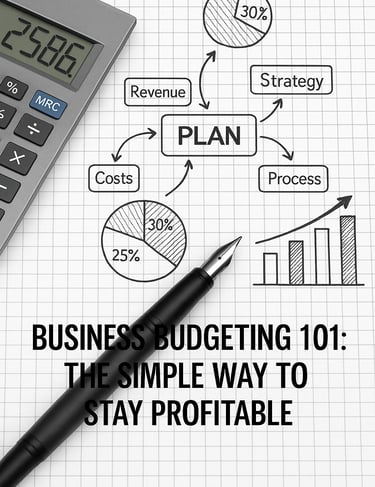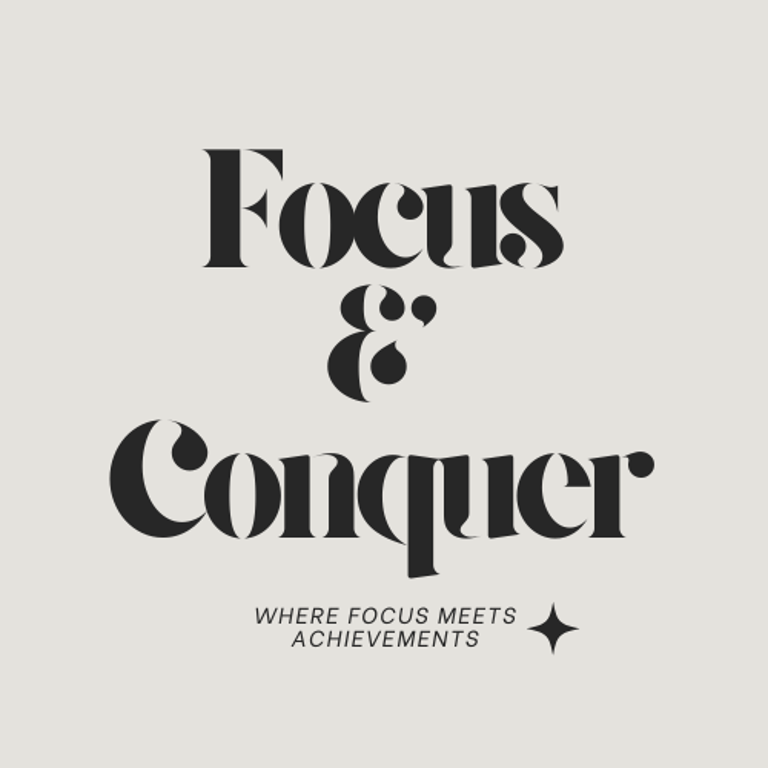Business Budgeting 101: The Simple Way to Stay Profitable
Learn how to create a simple, effective business budget that keeps your company profitable. Perfect for small business owners, solopreneurs, and freelancers. Includes free templates and tools from the Focus & Conquer finance collection.
5/28/20253 min read


1. The Moment I Realized My Business Was Bleeding Money
I’ll never forget the day I thought I had made a $5,000 profit—only to realize, after a late-night spreadsheet session, that I was actually $1,200 in the red.
As a financial expert, I should’ve known better. But like many small business owners, I was so caught up in building and selling that I neglected the one thing that makes or breaks a business: a budget.
Your business budget isn’t just about tracking money. It’s about making strategic decisions, understanding your numbers, and building a foundation for long-term success. It’s the difference between busy and profitable.
2. Why Most Small Businesses Don’t Budget (and How It Hurts Them)
Let’s be honest: budgeting feels boring. It’s not as exciting as launching a new product, closing a deal, or designing your brand. But it’s the quiet superpower behind every thriving business.
Here’s what happens without a budget:
You overspend on tools and software you don’t use.
You underprice your offers because you’re not calculating costs correctly.
You avoid taxes until they become a fire to put out.
You “feel” profitable but never have cash in the bank.
The truth? A lack of budgeting creates chaos. And chaos kills creativity, clarity, and confidence.
3. What Is a Business Budget, Really?
A business budget is a financial plan for your income and expenses. Think of it as a GPS for your money. It tells you:
Where your money comes from
Where it’s going
How much you can spend
What you need to save
Whether you’re on track to hit your goals
Your budget doesn’t need to be complex. It needs to be clear, consistent, and customized to your business.
4. The 5-Part Framework of a Profitable Business Budget
1. Revenue Forecast
Estimate how much money your business will earn each month. Use past sales, seasonal trends, or client retainers as your guide.
➡️ Tip: Always be conservative. Overestimating revenue is the #1 budgeting mistake.
2. Fixed Costs
These are your predictable, monthly expenses like:
Rent
Software subscriptions
Salaries or VA payments
Internet, utilities
Add them up. These don’t change much month to month.
3. Variable Costs
These fluctuate depending on your activity level. Think:
Marketing campaigns
Shipping supplies
Contractors or freelancers
Event or travel costs
Budget for these based on upcoming plans.
4. Profit Target
Set a goal for how much profit you want to keep. A great starting point: 20% profit margin. Reverse-engineer your budget to protect this.
5. Emergency & Tax Fund
Every month, allocate:
20–30% for taxes (varies by country)
A percentage for emergencies or slow months
This is what keeps your business safe when life happens.
5. Real-Life Example: Budgeting for a 1-Woman Service Business
Let’s say you’re a freelance web designer.
Monthly revenue goal: $6,000
Fixed costs:
Adobe Suite: $60
Website hosting: $20
Co-working space: $300
VA (10 hrs): $250
Total fixed: $630
Variable costs:
Ads: $200
Education/Coaching: $100
Client gifts: $70
Total variable: $370
Total expenses: $1,000
Target profit: $1,200
Owner’s pay: $3,800
You now know that your pricing and workload need to support this breakdown. If not, it’s time to adjust.
6. How to Build Your First Budget (In 20 Minutes)
You don’t need to start with a blank spreadsheet. Here’s what I recommend:
Step 1: Download my free Business Budget Template
Step 2: Plug in your monthly income and all expenses (fixed + variable)
Step 3: Calculate your profit (Income - Expenses)
Step 4: Adjust as needed to ensure you’re hitting your targets
Step 5: Review and update it weekly or monthly
Consistency > complexity.
7. Tools That Make Budgeting Easier (Even If You Hate Numbers)
I’ve tried dozens of tools, but these are my favorites:
My Budget & Finance Tracker Template — includes dashboard, graphs & expense tracking
QuickBooks Self-Employed (great if you’re in the U.S.)
Google Sheets (simple and free)
Notion (if you like aesthetic dashboards)
Need something done-for-you and ready to use today?
➡️ Get the Focus & Conquer Budget & Finance Tracker here.
8. The #1 Budgeting Mistake You’re Probably Making
Trying to be “perfect.”
Perfection will keep you stuck. Budgeting is not about knowing every penny—it’s about being intentional, proactive, and committed to improving.
Even if you get it wrong in month one, you’ll learn and adjust. And that’s real financial power.
9. Your Budget is Your Business Strategy
Your budget isn’t just numbers. It’s your strategy in action. It tells you:
What you can afford to delegate
Whether it’s time to raise prices
If your marketing is actually profitable
When to launch your next product
It helps you stop reacting and start leading.
10. Want to Go Deeper? Grab My new book.
If this post made you realize you need a system—not just tips—you’re going to love my new book: Financial Systems for Small Business; A practical System for Organizing Your Finances and Growing with Confidence
These are the tools I use to manage my own business finances and stay profitable every month.
Clarity Is the New Currency
If your business feels “busy but broke,” budgeting is the first step to turning it around. It’s not about restrictions—it’s about freedom. The freedom to know, decide, plan, and grow.
You deserve a business that’s sustainable, not stressful.
📥 Grab your templates.
📚 Read the guide.
💡 Build the system.
Because profitable businesses aren’t lucky. They’re budgeted.
